|
Entertainment growing
up in Elba, Nebraska
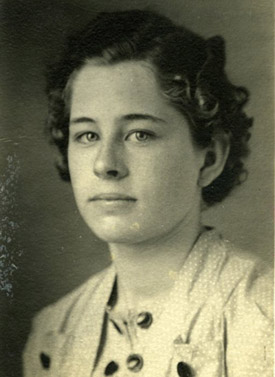
Betty Ann Barr
By Doug Boilesen, son of Betty Ann
Barr Boilesen.
Betty was born in 1924 and grew up
on a 640 acre farm which they called "River Ranch" as
it was located next to the North Loup River. She never lived in
a town until high school, however Elba, Cotesfield, Dannevirke,
St. Paul and Grand Island each would have influences on her entertainment
experiences while growing up.
Radio
As described in Betty Ann's story
The Hour of Charm,
the radio was an important source of entertainment for Betty and
her parents just as it was for other rural Nebraskan's who didn't
have access to professional entertainment other than the occasional
traveling show or band.
When Betty was around 14 she stayed
at the Keller's house as her parents had gone to York for the Golden
Anniversary of her Grandparents. She knew that her Dad and brothers
were giving her grandparents a radio for an anniversary present
so she called up to the radio station and requested them to play
"Silver Threads Among the Gold," then she listened and
waited to hear it play, proudly thinking that someone at the party
would probably hear the dedication from Betty Ann Barr to her grandparents.
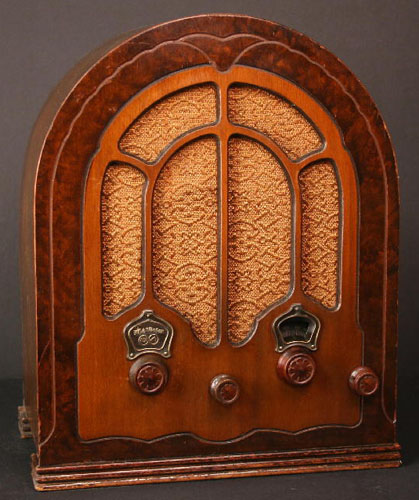
1933 RCA R-28 Cathedral
style tube radio
Movies
In the summers there were weekend
silent moving pictures shown in Elba during the teens and 1920's.
Since there was no movie theatre in Elba, the movies were projected
against the side of the Elba grocery store and people sat in the
empty lot next to the store on benches and blankets. I don't think
Mom remembered any of those silent movies in the 1920's as she was
much younger than her siblings. But movies did become part of her
entertainment world in the 1930's and her story titled The
Blue Hat - Going to the Picture Show takes place on a shopping
outing to Grand Island and includes her going to see Heidi
starring Shirley Temple.
Mom's older step-brother Chris who
was born in 1907, however, does have a story about those outdoor
Elba silent movies that he watched in the early1920's.
According to Chris he would ride his
horse to Elba on a Saturday night when the weather was good and
if it a movie was going to be shown. This would have been about
a 2.5 mile ride from his mom's family farm outside of Elba. Though
not a great distance he still would have been a teenager and it
would have been quite dark as there were no farm yard lights since
the Rural Electrication Administration did not yet exist. Lighting
for his journey therefore would have been primarily the light of
the moon. But that was no deterrent for Chris as he felt there was
nothing better than watching a good western moving picture on a
Saturday night.
I don't know the name of the movie
or who the star was (perhaps Hoot Gibson, Tom Mix, William S. Hart
or some other movie star of the day) but Uncle Chris remembered
a particular movie from some western serial (1)
which left him quite distraught. When the movie's single reel ended
for the night the situation was dire: the cowboy and and his horse
were stuck in quicksand and they were slowly sinking to certain
death.
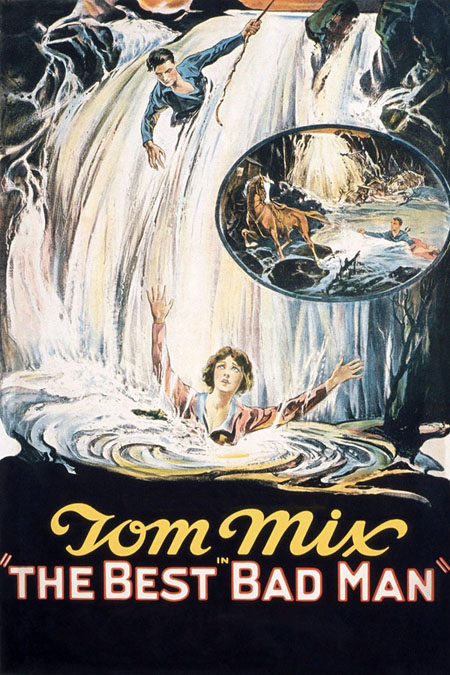
Tom Mix, The Best
Bad Man 1925
What scared Uncle Chris and what he
said he couldn't understand was how that unfortunate cowboy was
going to survive all week in that quicksand.
Now he probably told me that story
with a smile that I didn't notice as I was young and he might have
thought I wouldn't get the disconnect that this was only a movie.
Or perhaps when he originally saw it he really was worried all week
about the fate of that cowboy. Suspended belief, after all, has
its own reality.
Either way, movies were an important
part of entertainment in the 1920's even in a small village like
Elba. The new wonder of moving pictures had a unique power to captivate
audiences and make lasting impressions.
Dances
Dannevirke
was a small town in Howard County, Nebraska near Elba that was settled
in the 1880's and was named, of course, by the Danish immigrants
that settled there which included my great grandparents. It's a
town that my Dad wrote about in his story Growing
Up - My Danish Heritage. When we visited what remained of
Dannevirke in the 1990's I learned that my mom used to attend dances
there when she was growing up. Interestingly, it was here that she
would sometimes see Dad at a dance but I didn't hear that they ever
actually danced together.
The Community Hall is one of the
few buildings still standing in Dannevirke so we photographed it
with Mom at the door as a reminder of where she had loved to dance
and of course for its connection to the man who would be her future
husband.
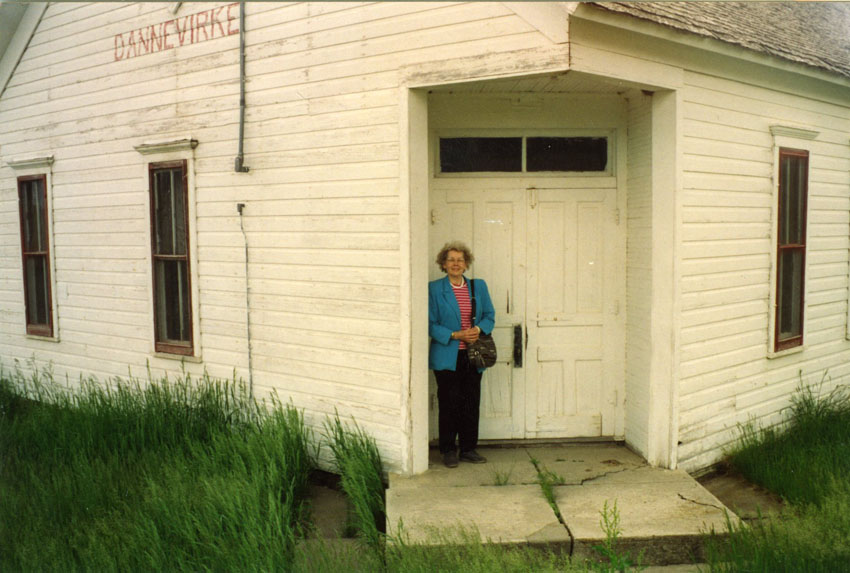
Dannevirke Community
Hall ca. 1992
Cards
My grandparents loved to play cards
and it's a tradition they passed down to Mom and her siblings and
in turn has been passed down to succeeding generations. Canasta
and Hearts were my grandmother's favorite card games. I think of
my grandfather as more of a Pitch player. My impression was that
the women of my grandparents generation played card games with their
women friends and that the men played with their men friends.
My grandpa Barr left me with several
important principles in playing cards:
"Bid 'em high and sleep in
the streets" was intended to remind me to not be overly cautious
in my bidding. I don't think he ever further explained that in
general you have to bid to win (because he was basically a man
of few words).
"Cut 'em thin, sure to win"
was another piece of advice apparently built on the belief that
luck and the cards dealt have a direct relationship with how you
cut the deck.
Finally, if the game was getting
out of reach go ahead and "shoot the moon". The final
score didn't matter if we ended up in the hole and the risk was
worth it because there was always a chance that we could get lucky.
My grandma Barr had other ways to
turn the tide if the cards weren't going very well. Her advice was
to get out of your chair and walk around the table, counter-clockwise,
to reverse the direction the game was going. I'm not sure she had
a magic number of times to walk around the table but I like the
number three (3) as it has the most folktale/popular culture
associations for me, e.g, three wishes, what's behind door number
3 (i.e., Let's Make a Deal aka The Monty Hall Problem), three little
pigs, three bears, three billy goats gruff, three blind mice, three
strikes and you're out, etc.).
Grandma Barr was also one who paid
attention to where the split in the table was for the leaves. My
grandparents had a round oak table where cards were always played
and it had multiple leaves that could be added for family and holiday
meals (which were taken out if cards were to be played). The line
that divided those two halves was said by my grandmother to be a
good place to be aligned when you played cards.
My grandparents didn't have a bathtub
in their house but for some reason my mom later added to the table
alignment strategy by saying that the chances of good hands could
be increased by partners in cards being seated in alignment with
the bathtub's direction in the house. My dad and mom played a lot
of bridge so maybe that alignment was part of their game plan. I
don't remember ever actually implementing that as a corrective action
if the cards went bad. For me, circling the table 3 times counterclockwise
seemed the only logical countermeasure to bad cards.
Phonograph and Records
When Mom was growing up only one of
her neighbors had a phonograph. She later wrote about hearing that
phonograph: "When we visited them, sometimes during the evening
we would all go to the parlor and listen to a few records. What
wonderful phonograph memories."
As to her own home, they never had
a phonograph or records although like everyone else they did have
a radio and much of the entertainment on a radio was courtesy of
the Phonograph. So in a way she listened to records all of her life.
For the story about one of the more
memorable songs she remembers from her youth, see her story "Shuffle
Off to Buffalo."
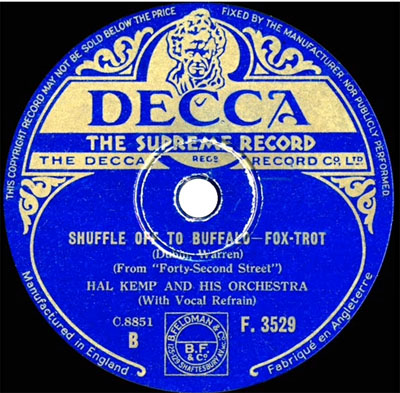
Listen to Shuffle Off to Buffalo
courtesy of TCM on Youtube.
Games
Checkers, cards, and parcheesi are
games I know were played in the Anna and Manley Barr home. They
had a Carrom board with pool sticks and red and green wooden rings
and on the other side there was a checkerboard, which I believe
was simliar to this Carrom Viking "Q" from the late 1930's.

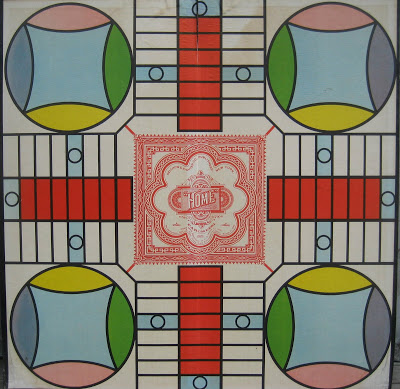
Parcheesi game board,
ca 1938 (1)
Mom also told the story
of the mysterious powers of the Ouija board which she saved for
use only when a girlfriend would spend the night. It was probably
during one of those stay-overs that an Ouija board confirmed who
she was going to marry.
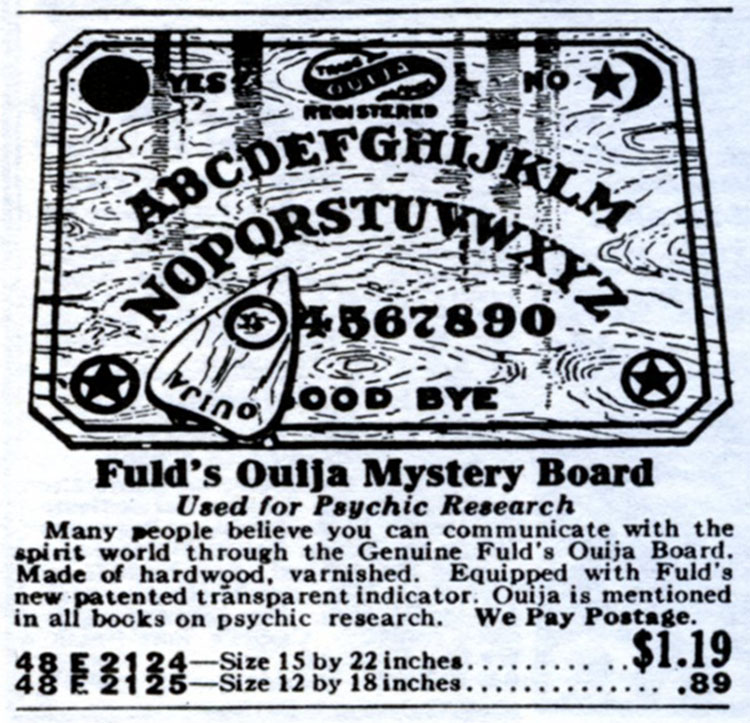
This Ouija Mystery
Board from a Montgomery Wards & Co. Catalogue in 1930
Croquet
A game mom said that she always wanted
to play growing up was croquet. Perhaps she had been inspired by
a croquet image or a story that she had read. On their farm there
was a flat, weedy area close to their house that she always wanted
to keep mowed as a potential croquet court. They never did own a
croquet set and although that field was mowed by their goat
it never did host a croquet match.
Years later, however,
croquet games would be played on her
own backyard lawn in the suburbs of Lincoln, Nebraska. On that
court playing croquet would become a family tradition particularly
after a holiday or birthday party dinner.
|
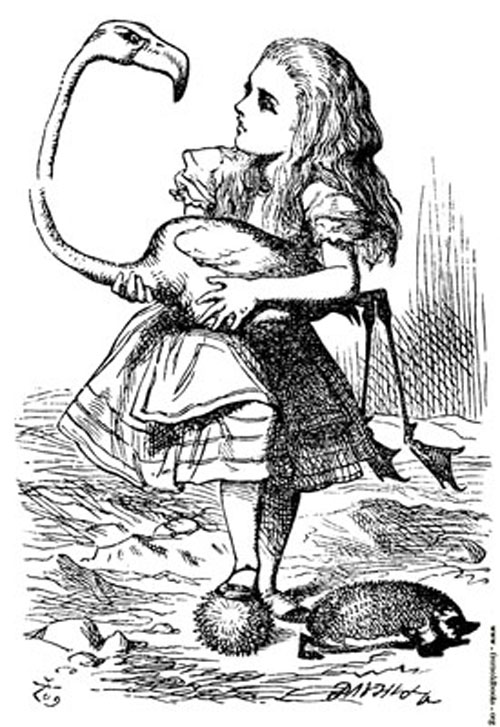
Alice playing croquet
with flamengo and hedgehog, 1865 John Tenniel
|

Norman Rockwell, September
5, 1931
|
Comics
The newspaper featured comic strips
that were something everyone in the family looked forward to reading..
Bringing Up Father, Little Orphan Annie, Mary Worth, Gasoline
Alley, L'il Abner, Mutt & Jeff, The Katzenjammer Kids and
many more.
|
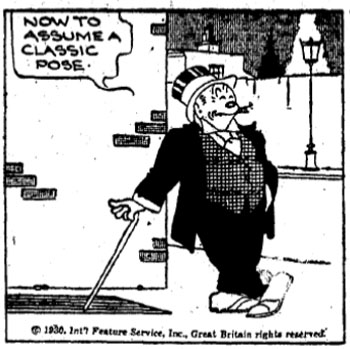
Bringing Up Father
by George McManus, June 4, 1930
|
|
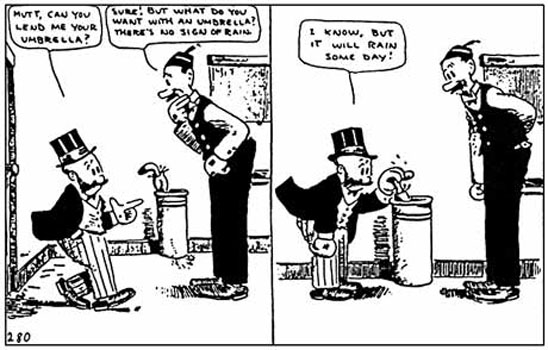
Mutt & Jeff by
Bud Fisher
|
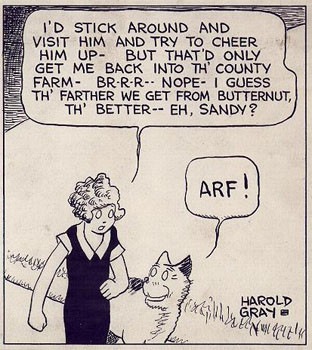 |
|
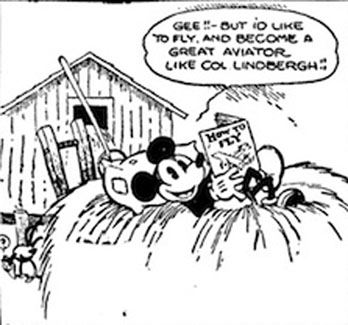 |
|
September 22, 1936
by Harold Gray
|
|
Panel from Mickey Mouse's
first comic strip, January 13, 1930
|
Mom had several Little Orphan Annie
Big Little Books when she was growing up. I remember seeing
some of these on my grandparents bookshelf in the 1950's, perhaps
put there for the grandchildren to enjoy.
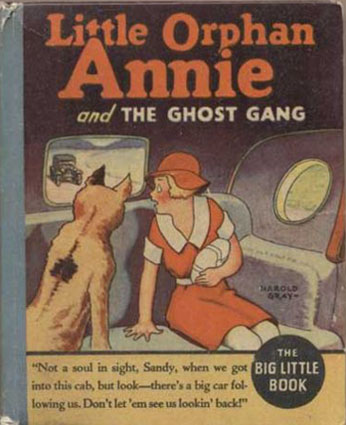 |
|
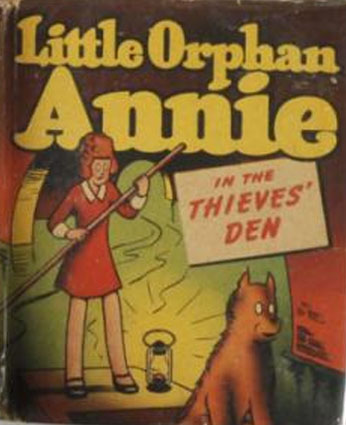 |
|
Whitman Publishing
Company, 1935
|
|
Better Little Book
1948 (2)
|
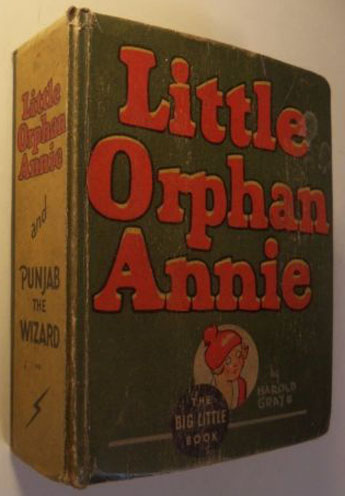
Little Orphan Annie
and Punjab the Wizard, The Big Little Book, 1935
Dolls
Mom didn't have many dolls but her
favorite was a Shirley Temple doll similiar to this doll from the
1930's. She also had a doll that she named "Beverly"...
a name that she would later give to her own baby daughter.
For her most memorable Christmas story
involving a doll, see her story The
Christmas Dolls.
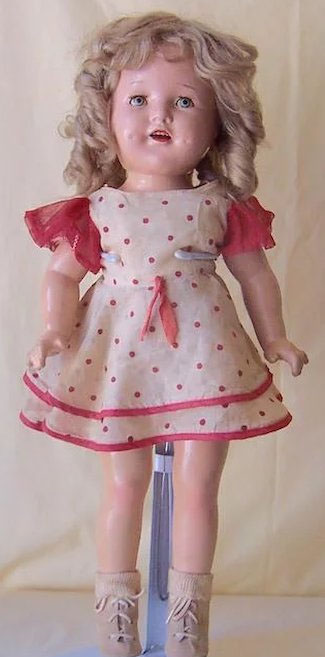
Shirley Temple ca. 1935
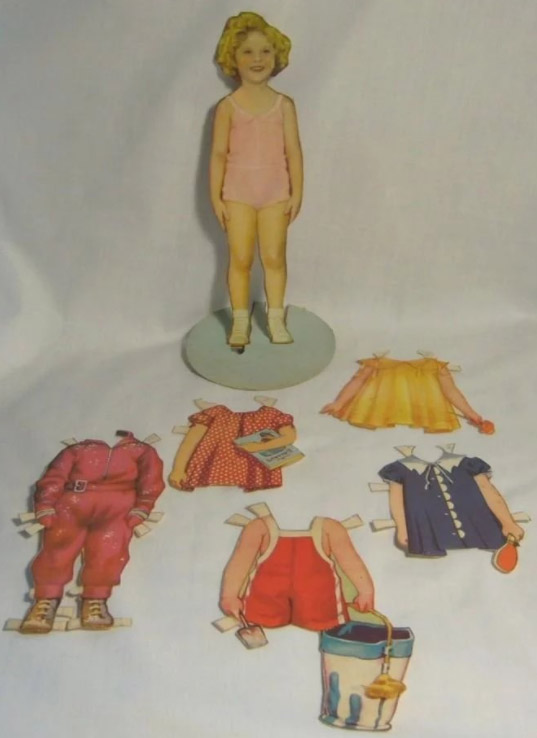
Paper dolls were a popular playtime
activity for girls in the 1930's and Shirley Temple was naturally
a favorite.
Toys
The Balky Mule was a tin toy made
by Lehmann's between 1897 and 1938. It was one of the most common
of the Lehmann wind-up toys. When I was very young I saw a toy simliar
to this in a trunk in my aunt's garage in Elba. My aunt told me
that the trunk had belonged to my mom. I don't know what happened
to this toy or if The Balky Mule was the same windup toy
that I saw in that garage. A more likely toy for her was probably
the "Balking Mule"
(3) which was a Marx knock-off
of the Lehmann toy.
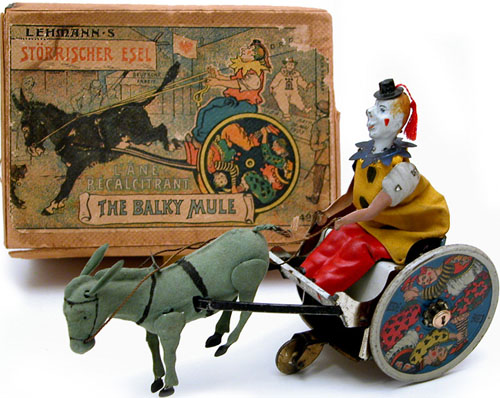
Besides mom's Shirley Temple doll,
the only toys that survived were a small wooden kitchen cabinet
where she kept her doll's china, a wooden bed, a tin toy cook stove,
some doll cups and sauces and a few small dolls including a hand-made
stick doll in red clothes. I don't know if my grandfather made the
cabinet and bed, and they may even have first belonged to my mom's
older step-sister (which would make them ca.1912). These toys are
now part of the Stuhr Museum collection in Grand Island, Nebraska.
| |
|
|
|
|
|
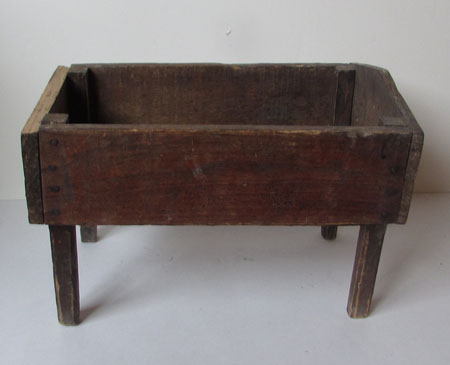
Wooden doll's bed, homemade circa
1928
|
|
Wooden doll's kitchen
cabinet, homemade circa 1928
|
|
|
| |
|
|
|

Tin toy kitchen stove
|
|
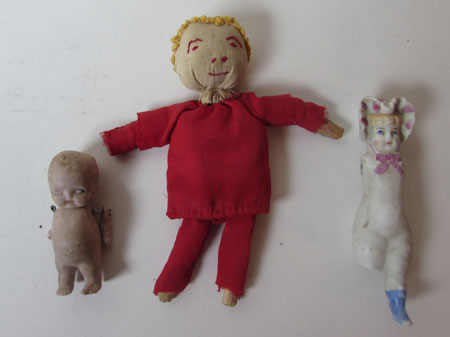 |
|
|
|
Assorted small dolls
|
| |
|
|
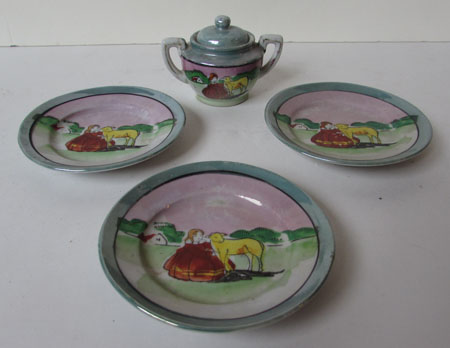
Mary had a little
lamb doll china plates and sugar bowl
Growing up in rural Nebraska in the
1920's and 1930's was a time of significant changes and challenges.
The USA would go from the Roaring Twenties to the Great Depression
to entering World War II the time when Betty was in High School.
Home entertainment would see the rise
of the radio's domination over the phonograph while movies would
continue to redefine entertainment with the addition of talking
pictures and Technicolor.
I believe Mom's most enjoyable entertainment,
however, came from her own imagination and from the visits of relatives
or girl friends coming out to their farm. She loved reading and
writing (see an early poem from grade school in Education
- Growing Up in Elba) and going to school where she could be
with her friends. And she always looked forward to trips to the
big city - Grand Island.
She also enjoyed simply observing
strangers. She once described how she would stand by the railroad
tracks near their farm as a young girl and watch the passenger train
go by and look at the people sitting on the train and wonder who
they were and where they were going.
Although her family would lose their
"River Ranch' in the Depression and her 'entertainment' opportunities
may seem very limited compared to 21st century options, I think
her world of entertainment, growing up where and when she did, resulted
in experiences that she enjoyed at the time and valued in later
years as evidenced by the memories and stories she would later share
with family and friends.

Other
Betty Stories Menu
|